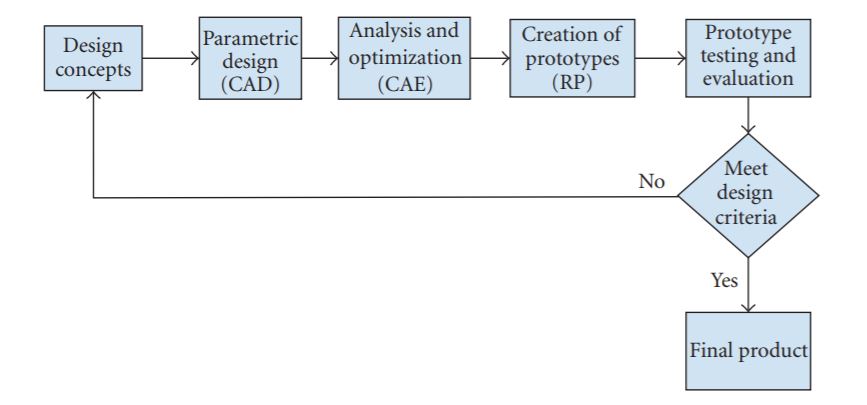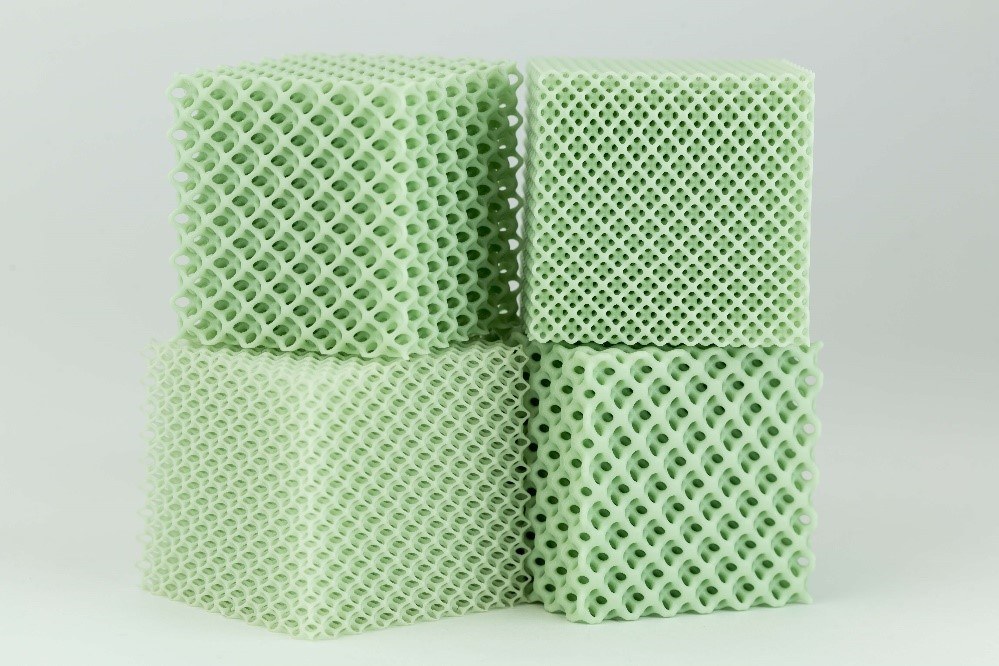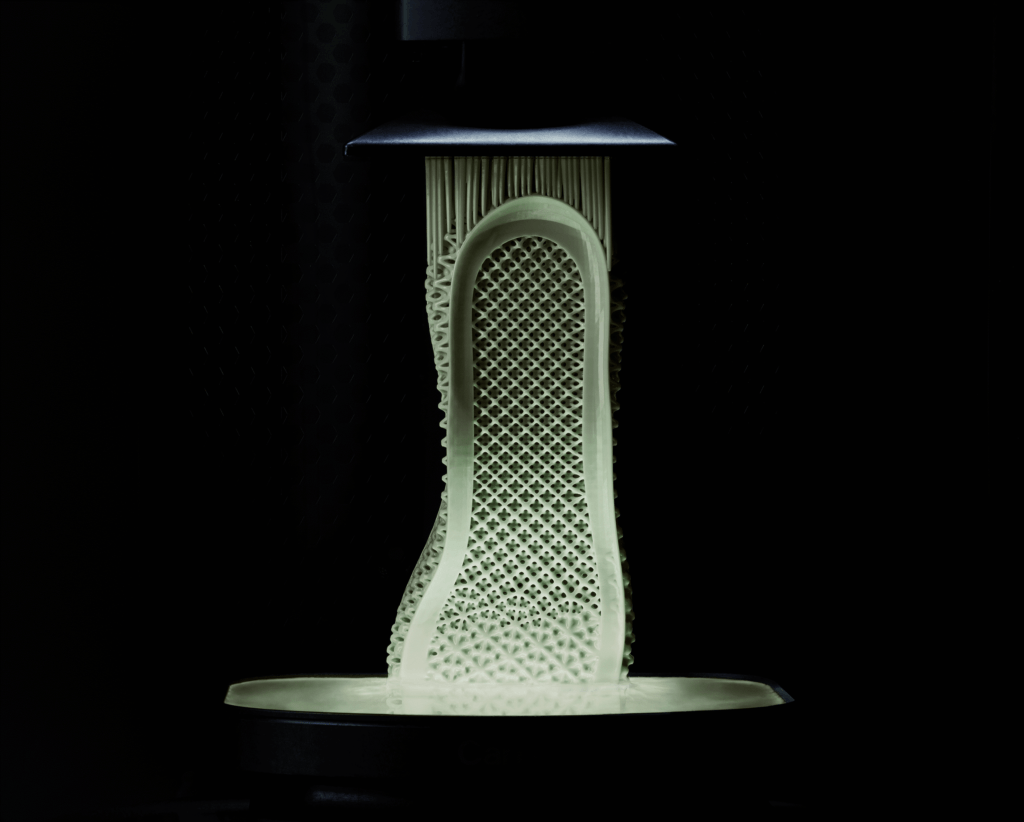Printing the Future of Athletic Shoes at Adidas

As the speed and quality of additive manufacturing improves, innovative companies like Adidas are bringing 3D printing from the prototyping lab to the manufacturing floor.
Since its beginnings in the 1980’s, additive manufacturing (also known as 3D printing) has become an increasingly valuable tool for engineers and designers. By creating one-off parts layer-by-layer from CAD data, the technology allows engineers and designers to rapidly iterate on prototypes in a fraction of the time required using traditional manufacturing methods[1]. Furthermore, this layering process allows for the formation of complex geometries and microstructures that were previously impossible to manufacture. Historically, additive manufacturing has been restricted to the R&D space due to its high per-unit cost, but recent advancements have made the technology feasible for mass manufacturing applications as well. Companies like Adidas are now turning to 3D printing to produce their next generation products, opening design possibilities that were previously unavailable with traditional manufacturing. As Adidas surveys the shifting landscape of manufacturing, they need to be thoughtful in the way they implement this new technology into their products in order to maintain a competitive advantage in the years to come.
In Adidas’ highly competitive world of athletic apparel, companies are constantly striving to find ways to improve the performance of their products. In order to facilitate rapid innovation, the product development cycle is continuous and involves multiple iterations. As Tony Bignell, director of Nike’s footwear category noted: “The process is dynamic, fluid, and evolving. Nothing ever stops; we just keep learning and innovating”[2]. Rapid prototyping techniques such as additive manufacturing play a critical role in Adidas’ product development process. Designers can quickly prototype, test, and tweak designs without the high costs and lead times associated with full production runs. Without the rapid-prototyping ability that 3D printing affords Adidas’ product design team, they would quickly fall behind their competitors.


Adidas should continue to invest in 3D printing technologies to bolster their brand image as the most innovative shoe designer in the industry. Products like the Futurecraft 4D will build excitement and bring new customers to the brand who are looking for the newest technology. Long-term, I believe that complete customization will be the next frontier for their business. Just as no two athletes are the same, additive manufacturing gives Adidas the ability to produce unique shoes for each individual. Each Adidas store could be outfitted with 3D scanners to generate 3D models of each customer’s feet. Software could then automatically design the perfect shoe sole for that individual, which could then be printed onsite. This ability to cater to the individual consumer will be what sets Adidas apart from its competitors in the future.

[786 words]
[1] Wong, Kaufui V. and Aldo Hernandez, “A Review of Additive Manufacturing,” ISRN Mechanical Engineering Vol. 2012, 208760 (June 17, 2012)
[2] Ofek, Elie and Ryan Johnson. “Nike Football: World Cup 2010 South Africa,” Harvard Business School 9-511-060 (January 17, 2013), 3.
[3] Carbon Website: https://www.carbon3d.com/process/
[4] Patel, Dinesh K. et al. “Highly Stretchable and UV Curable Elastomers for Digital Light Processing Based 3D Printing,” Advanced Science News 1606000 (December 30 2016), 1.
[5] Andria Cheng, “How Adidas Plans to Bring 3D Printing to the Masses,” Forbes (May 22, 2018).
[F1] Wong, Kaufui V. and Aldo Hernandez, “A Review of Additive Manufacturing,” ISRN Mechanical Engineering Vol. 2012, 208760 (June 17, 2012)
[F2], [F3] “Carbon Lattice Innovation- The Adidas Story” from Carbon Website: www.carbon3d.com/stories/carbon-lattice-innovation-the-adidas-story/ accessed November 2018.



Very interesting read! 3D printing in the shoe space has many advantages including the ability to create hollow figures, reduce waste, and produce overall greater structural integrity. An added benefit to adidas that is slightly overlooked is the transferability of 3D printers themselves. Since there are no specific molds, the switchover cost per machine is marginal implying that adidas can optimize for a dynamic production line that can cater to demand on a live basis, thereby reducing distribution costs on a whole. I would be interested to hear your thoughts on how adidas could capitalize on the technology and whether it should bring 3D printing machines in-house and dedicate separate R&D teams to it or continue outsourcing this type of machinery to specialists. If adidas choses the latter, what measures can it take to protect its IP and how much ownership will it really have on its designs.
Manufacturing customized shoes does sound very interesting, but how feasible is this technology for a $50-$100 shoe that people typically buy? Would that be fast enough, and how can Adidas convince a consumer that the 3D printed shoe will work as great as a conventionally manufactured one? I believe that the problem going ahead is going to be more around positioning this idea to the consumer than the operational feasibility.
Interesting read. I see how further advancements in 3D printing (if done in scale) can make the production process more efficient, but how costly will be it be for Adidas to use 3D printing to customize shoes on a per customer basis given the limited margin on the products? Also, understand that Nike offers a traditional customizable purchasing process that has not been outperforming in recent years, so would a similar product offering really have a market for Adidas? Nonetheless, I really enjoyed learning about how Adidas is taking advantage of 3D printing to advance product manufacturing.
As mentioned in the comments above, I’m concerned that a fully customized shoe to customers may not gain significant traction with customers. Many customers are prompted to buy shoes by seeing something that we like as opposed to going out to look for something that is similar to a customized idea we had in mind. I therefore think there is value in having thoughtful and attractive designs that prompt customers. Additive manufacturing may, however, have significant benefits in the production of insoles or add-ons that improve the comfort and performance of shoes.
Awesome article! I had heard how prohibitively expensive 3D printing can be, so it is interesting to learn that Adidas believes they can be profitable when they hit 100K pairs of shoes. It sounds like this technology will set them well up for on demand customization (both in terms of style and fit) — which reminds me of how you can customize shoes on Adidas’ site which I know has been very popular.
I also wonder what this means for counterfeits. With 3D printing it seems like it would be much easier to create exact replicas (assuming the 3D machine isn’t prohibitively expensive).
Very interesting article and topic. I love the idea of customizing shoes’ soles to improve the overall shoe design and maybe solve discomfort issues for everyday’s users and not only athletes.
However, I wonder how the profitability after 100k pairs of shoes sold compares to more “classical” production methods.
Also if successful, I have trouble to see what could be a barrier to entry for Adidas main competitor, Nike. The technology has been here for quite some time and has been grabbing attention from industrial manufacturers. Do you believe the company really plan to build on this production method or instead is trying to deploy a marketing campaign?
I thought this was a very interesting application of additive manufacturing in the B2C segment. One thing that comes to mind is the value that 3D printing brings to Adidas as a brand. From the product side, I don’t see much value in 3D printing in terms of performance. Adidas should invest more into finding materials that have better performance than rubber so that they can bring value to the product.
I also think their pricing strategy will be key in commercializing lattice-like soles in Adidas shoes. You mention that they will break even after 100,000 shoes, but I’d be interested in what else needs to be true for using 3D printing for soles to cost the same as current methods of manufacturing. If that is not possible, how will Adidas value the incremental benefit of having 3D printed soles vs. rubber soles?
It was interesting to see a company really put in practice the rapid trial and error philosophy that we’ve learned about in FIELD and TOM (spaghetti challenge, Shad challenge). I wonder if and how this has given them a competitive edge against other players in the space, or if most companies adopt this design thinking. Given the potential of this technique for Adidas, I think they should consider not only partnering with Carbon, but acquiring it altogether. In terms of how they will convey value to the customers, I think the first question to answer is: “Who are the customers?” Are they professional sports players, high end retail customers, or retail customers more generally. In line with their previous strategy, I think focusing on function and professional endorsements will help them create the most demand.
This is a very interesting topic, especially since the term does get mentioned quite a lot without really being explained. The CLIP approach especially resonated with me and I am excited to see whether it will enable transition from prototyping to mass production. To address your question, I believe Adidas should go all in with CLIP, because it will enable the company to gain long-term competitive advantage through offering customized products at a level unheard of before. And it also does not hurt that Adidas is a large company able to overcome significant R&D costs. I also agree that marketing campaign will be crucial when the company gets to mass manufacturing. I believe the company should focus on the innovative and functional side of the product in short-term, but in medium-term it should emphasize the personalized nature of the product and aspire to create an emotional bond with target customers.
Fascinating post! To demonstrate the power of 3D printed, customized shoes, I would focus on two go-to-market strategies:
1) A-list athlete brand ambassadors – partner with top top-performing athletes to highlight the innovative, scientific, performance qualities of the shoes
2) Create “Adidas Labs” in flagship stores where regular customers can have their feet measured and can customize designs – brick & mortar/in-person human-human service is a great way to control the experience and the process of rolling out the technology.
Loved this post! I found surprising that 3D printing can be cheaper than traditional manufacturing for large-scale production. I found the point about being able to design a unique shoe for each customer on-site extremely interesting. However, is this really an option? What would be the price that Adidas would need to charge to this customers? I assume that every customer requires new measurements, transferring data to the 3D printing, printing it, etc. and I cant imagine this being profitable at “normal” prices.
Interesting post Zack! Thank you for sharing.
One thing I struggle with here is the cost feasibility to apply current 3D printing technology to consumer sports shoe manufacturing. Given the relatively low prices one can charge in order to stay competitive (in an industry with fierce competition from Nike and Puma to name a few!), I wonder how long it will take before the technology becomes cost effective enough to replace current manufacturing processes that are done in low cost regions in the world. Additionally, given the humongous number of SKUs Adidas probably has, current 3D printing technology (as I know it and I’m definitely not an expert!) makes it difficult to change from one design to the next.
Great article! I’m looking forward to my first pair of custom shoes. That said, I wonder how healthy the use of additive manufacturing technology is for the shoe industry. My concern is that it may not cost startups enormous amounts of money to buy the equipment for 3D manufacturing and robust supply chains may become less necessary. This would happen if labor content shrinks in the cost structure and smaller lots can be produced at the same price. The result of this, I’d guess, is the invitation of significant competition (in addition to Nike). If this happens, it’s possible that industry profits decline as prices, and margins, shrink. The differentiator in the industry is likely then design. Will Adidas be able to retain its ownership of design leadership, or will technical design become commoditized as blueprints for shoes proliferate?
Wonderful Article!
As described in the link below, the shoe manufacturing process involves a lot of manual work.
https://sneakerfactory.net/sneakers/2018/01/how-does-a-factory-make-shoes/
3D printing technology has the potential to change the process drastically. Moreover, sneakers can be more technology oriented if manufacturers apply 3D printing in their manufacturing process. I really wish to know more about the progress in this area in the future!
Very interesting article! I personally believe that leveraging 3D printing to create customized shoes for customers without having to incur additional costs or operational inefficiencies would create a competitive advantage for Adidas. While I believe that your questions about how should Adidas strategically pursue those goals and how should it convey this competitive advantage to customers are very strong points, I have a different concern that I am curious to know if its valid. I would like to know whether the materials involved in creating these shoes using 3D printing are different than those used in traditional shoe manufacturing. If so, what are the implications on the environment? Do we have to consider different practices to recycle them or dispose them? And would they have a worse footprint on the environment compared to traditional materials? Also, if true what would be the impact of regulatory and environmental policies on the business considering this transition towards 3D printing?
Very interesting! Curious how/if this shapes the way Adidas will think about its manufacturing locations. If smaller shoe batch sizes are possible with 3D printing, perhaps Adidas will move to decentralize its operations. In this event, shipping costs to consumers are likely to decrease. Curious if this impact would drive the cost of shoes down in the long run even lower
Amazing article! Very interesting to see the breakeven point for the company would be 100,000 shoes. Echoing the above comments, I do think they have indicated a number that seems too low. However, I see the value in the competitive advantage this could be for Adidas, clearly positioning it apart from its competitors and at the cutting-edge of technology. With the right Marketing strategy, Adidas would have the opportunity to go viral with this product. With sport shoes more and more focused on customization and analysis of the customers’ type of footstep, 3D printing would take it to the ultimate level. In addition, the current trend for health conscious and sports makes customers more interested about new products in this industry. I struggle to believe the numbers, but if they do make financial sense and the shoes are priced at a reasonable level, then I would definitely be one to want to try these 3D printed shoes!